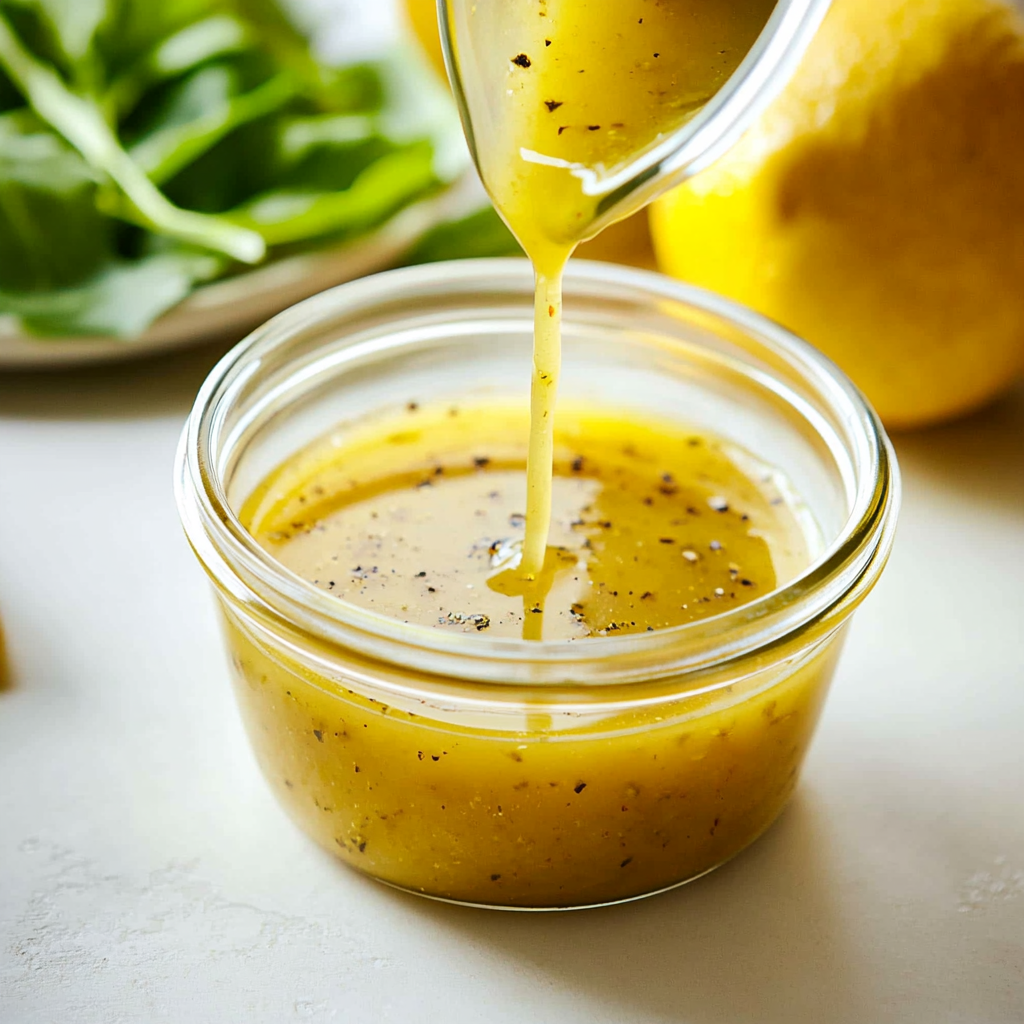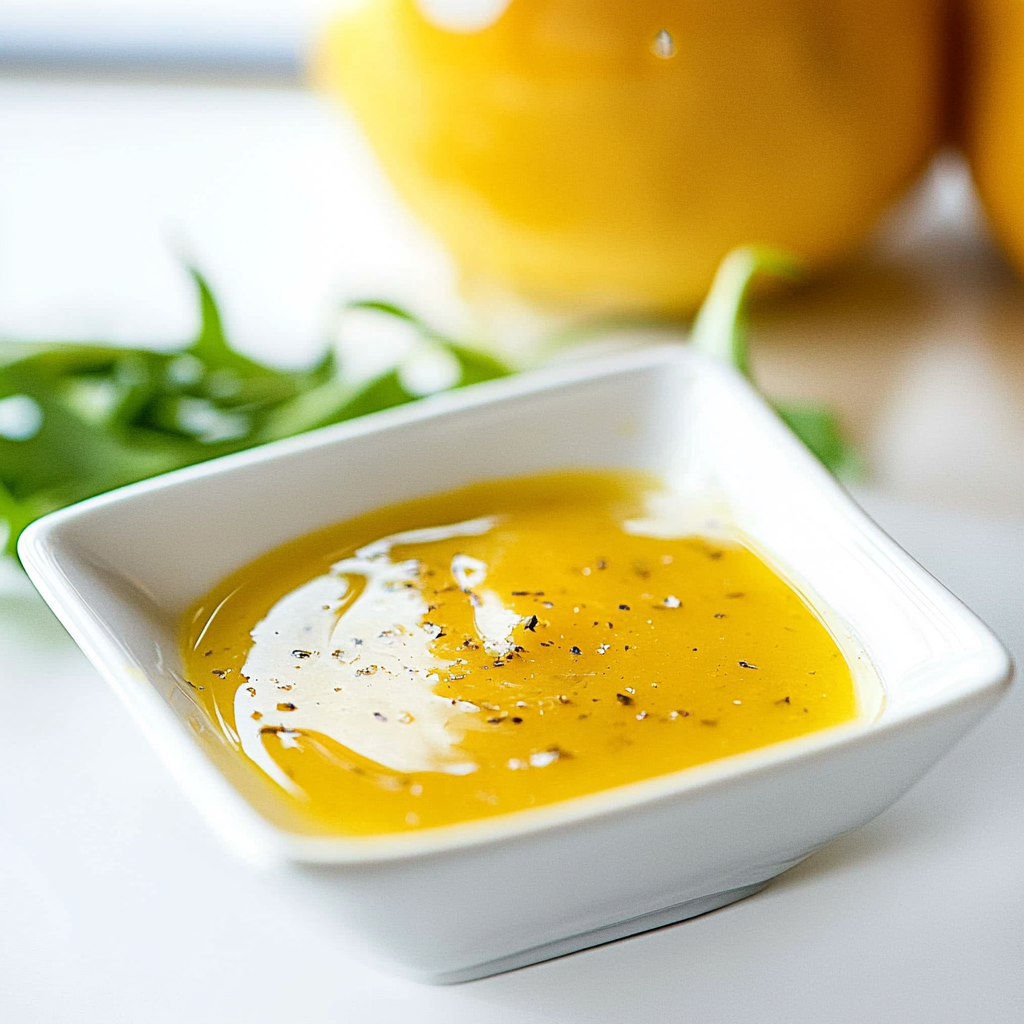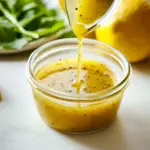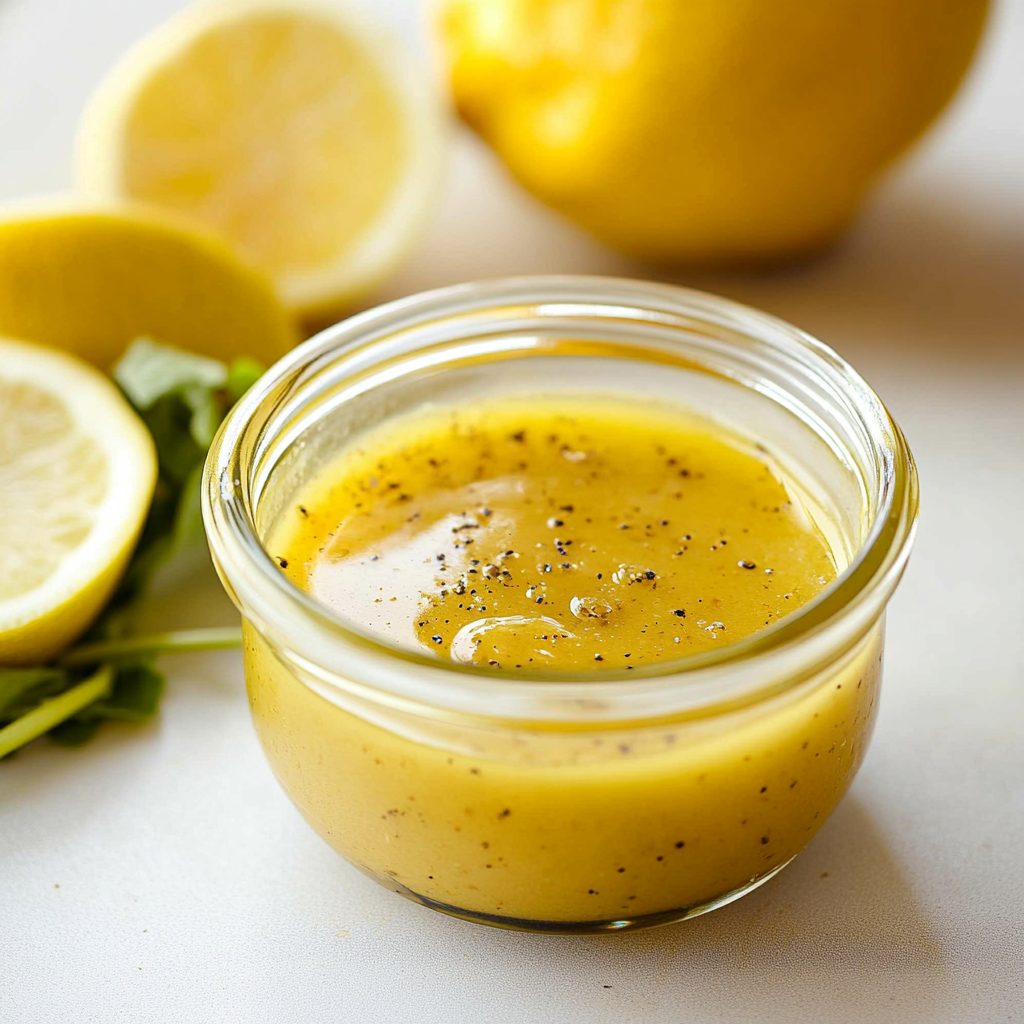Lemon vinaigrette is a delightful dressing that can elevate any dish, transforming a simple salad into a culinary masterpiece. This versatile dressing combines the bright, zesty flavor of fresh lemons with the richness of olive oil and a hint of sweetness from honey or maple syrup. Not only is it easy to prepare, but it also brings a burst of freshness that complements grilled vegetables, fish, and even pasta dishes. Whether you’re hosting a summer gathering or simply preparing a meal at home, this lemon vinaigrette will add an irresistible tang to your plate.
In just a few simple steps, you can whip up this refreshing lemon vinaigrette that will keep your taste buds dancing. You’ll find that making your own dressings allows you to control the ingredients and avoid preservatives found in store-bought versions. Plus, this recipe is customizable; feel free to adjust the acidity or sweetness according to your preference. With its bright color and vibrant flavor profile, this dressing not only enhances the taste of your meals but also adds visual appeal.
Ready to get started? Let’s dive into the main ingredients you’ll need for this lemon vinaigrette recipe!
Main Ingredients
Fresh Lemons
Fresh lemons are the star ingredient in this recipe. You’ll need about three medium-sized lemons for approximately half a cup of juice. Lemons provide the zingy acidity that characterizes this vinaigrette. When selecting lemons, look for ones that are firm and heavy for their size; they should feel juicy when squeezed gently. Roll them on the counter before cutting to release more juice. Freshly squeezed juice is paramount; avoid bottled lemon juice as it lacks the vibrant flavor found in fresh fruit.
Extra Virgin Olive Oil
Extra virgin olive oil plays a crucial role in creating a well-balanced vinaigrette. For this recipe, use about one cup of high-quality extra virgin olive oil. This oil adds richness while helping to mellow out the tartness of the lemons. The flavor profile can vary significantly between brands; try different oils to find one that complements your palate best. Olive oil not only enhances taste but also offers health benefits such as antioxidants and healthy fats.
Honey or Maple Syrup
To balance the acidity of the lemons, we’ll incorporate a sweetener—approximately two tablespoons of honey or maple syrup work wonders. Honey provides a floral sweetness that pairs beautifully with citrus flavors, while maple syrup gives an earthy undertone. Feel free to adjust the quantity based on your taste preferences or dietary needs; using less sweetener will yield a tangier dressing.
Dijon Mustard
Dijon mustard adds depth and complexity to our lemon vinaigrette with its sharp yet creamy texture. You’ll need one teaspoon for this recipe. The mustard not only contributes flavor but also acts as an emulsifier—helping blend oil and vinegar smoothly together without separating. Choose whole grain or smooth Dijon according to your preference; both options work well in this recipe.
Salt and Pepper
Finally, seasoning is essential for bringing all these flavors together! Use around half a teaspoon of salt and freshly ground black pepper to taste. Salt enhances each ingredient’s natural flavors while pepper adds subtle heat and depth without overpowering the freshness of the other components.

How to Prepare Lemon Vinaigrette
Step 1: Squeeze Fresh Lemons
To start making your lemon vinaigrette, wash three medium-sized lemons under cold water to remove any wax or residue from their skin. Cut each lemon in half using a sharp knife and squeeze them over a bowl or measuring cup to extract their juice. A citrus juicer can help you get every last drop out while filtering out seeds effectively if any get into the mix! Aim for about half a cup of fresh lemon juice—the key component that makes this dressing so refreshing.
Once you’ve squeezed all three lemons, give it a good stir with a fork or whisk to combine any pulp left behind evenly throughout the liquid! Freshly squeezed lemon juice should be bright yellow-green in color and smell invigorating—a sign that it’s ready for use!
Step 2: Combine Ingredients
In another mixing bowl or jar with an airtight lid (for easy storage), add one cup of extra virgin olive oil alongside two tablespoons of honey (or maple syrup) along with one teaspoon of Dijon mustard—these three ingredients will create harmony with our tart base we’ve just prepared! Before combining everything together thoroughly using either an immersion blender if preferred or simply whisking by hand until fully emulsified—ensure no separation occurs between oils and liquids which would affect consistency later on when serving!
This step may take some time depending on how vigorously you’re whisking—don’t rush through it though as achieving proper emulsification is crucial here! The mixture should look creamy yet pourable once complete—if desired add salt (around half teaspoon) plus freshly cracked black pepper directly into bowl/jar too during this stage ensuring all flavors meld nicely before proceeding further down our list!
Step 3: Taste Test & Adjust Seasoning
Now comes one of my favorite parts—the taste test! Dip in fresh greens like arugula or spinach into our mixed-up concoction then savor every bite whilst assessing what adjustments might be necessary regarding sweetness/tartness levels present within current batch prepared thus far! If things seem too tart go ahead adding more sweetener until reaching desired balance achieved effortlessly adjusting flavors according personal preferences along way plus always remember seasonings play important role here too!
If needed sprinkle extra pinch salt/pepper if lacking depth still after initial sampling done earlier don’t hesitate either experimenting other spices/herbs available within pantry such garlic powder/dried oregano could lend additional nuances enhancing overall profile greatly! Once satisfied set aside dressed greens separately just before serving next step can commence straight away without missing beat!
Step 4: Storage Tips
If you have leftover lemon vinaigrette after preparing delicious salads don’t fret—you can store any remaining portions easily within refrigerator using airtight container/jar designed specifically keeping contents fresh longer periods time before going bad prematurely! Just remember though—it’s best enjoyed fresh made right away since flavors tend fade over time losing brightness associated initially felt when first tasted!
For optimal storage conditions ensure keeping tightly sealed minimizing exposure air where possible while also avoiding direct sunlight which causes oxidation negatively impacting quality overall significantly even after short durations involved here potentially leading separation occurring inside jar too! Typically lasts anywhere between week-two weeks maximum depending on freshness used initially although always checking signs spoilage beforehand consuming again later down line remains prudent practice worth noting overall!
Serving
Mistakes to avoid
Ignoring Ingredient Quality
One of the most common mistakes when making lemon vinaigrette is using low-quality ingredients. Each component plays a vital role in the overall flavor, so it’s essential to choose fresh lemons, high-quality olive oil, and fine vinegar. Fresh lemons provide a vibrant acidity that enhances the dressing. If you opt for bottled lemon juice, you may miss out on the bright flavor and aroma that fresh juice can deliver. Similarly, using subpar olive oil can lead to a flat taste. Extra virgin olive oil is preferred due to its rich flavor and health benefits. For vinegar, consider using white wine or apple cider vinegar for their complementary flavors. Always taste your ingredients before combining them; this ensures you achieve the best possible result.
Over complicating the Recipe
Another common mistake is over complicating your lemon vinaigrette recipe with too many ingredients or unnecessary steps. The beauty of this dressing lies in its simplicity. A basic lemon vinaigrette requires just three fundamental components: lemon juice, olive oil, and salt. If you add too many additional ingredients like herbs or spices, you risk overshadowing the fresh lemon flavor that defines it. Stick to the basics and add complexity gradually if desired. This way, you maintain balance without losing the essence of what makes a great lemon vinaigrette.
Using Incorrect Ratios
Getting the ratio of lemon juice to olive oil wrong can ruin your vinaigrette’s taste and texture. A common guideline is a 1: 3 ratio of acid (lemon juice) to fat (olive oil). If you use too much lemon juice, your dressing may become overly tart and unpalatable. Conversely, if there’s too little acidity, the vinaigrette will taste greasy and lack flavor depth. Always start with this basic ratio and adjust according to your personal preference while keeping in mind that balancing acidity with fat creates harmony.

Tips and tricks
Embrace Fresh Herbs
Incorporating fresh herbs into your lemon vinaigrette can elevate its flavor profile significantly. Simple herbs like parsley, basil, or chives complement the zesty notes of lemon beautifully. To incorporate herbs effectively, finely chop them before mixing them into your vinaigrette. This allows their flavors to infuse more readily into the dressing. Just remember not to overdo it; a tablespoon or two should suffice depending on how herbaceous you want your vinaigrette to be. Try different combinations based on seasonal availability for unique twists on this classic recipe.
Whisking Techniques
The technique used while whisking your lemon vinaigrette can influence its final texture and cohesiveness. When combining the oil with the acidic components like lemon juice, use a steady whisking motion rather than simply stirring it together. This action helps emulsify the mixture, creating a creamy consistency rather than a separated one. If you’re struggling with achieving emulsion by hand, consider shaking all ingredients in a jar with a tight-fitting lid for about 30 seconds instead—a quick and efficient method that yields excellent results.
Experimenting with Additions
Don’t hesitate to experiment with additional flavors in your lemon vinaigrette! While the classic version is fantastic on its own, adding ingredients such as Dijon mustard can introduce an extra layer of depth and creaminess without altering its essence too much. You might also consider adding honey or maple syrup for sweetness if you’re working with particularly tart lemons; these sweeteners help balance out acidity beautifully while still allowing that refreshing citrus flavor to shine through.
Suggestions for lemon vinaigrette
Storage Tips
To keep your homemade lemon vinaigrette fresh for longer periods, proper storage is crucial. After preparing it, transfer it into an airtight container or glass jar with a lid—this prevents air exposure that could diminish its quality over time. Store it in the refrigerator where it usually lasts up to one week due to the natural preservatives found in vinegar and oils used in dressings. Before each use, give it a good shake or stir as separation may occur—this is normal due to varying densities of ingredients.
Pairing Ideas
Lemon vinaigrette pairs wonderfully with salads but also enhances various other dishes! Consider drizzling it over grilled vegetables for added zest or using it as a marinade for chicken or fish before cooking—a simple yet effective way to infuse flavor into proteins! It can also serve as a dip for fresh veggies during gatherings or picnics; its bright taste complements everything from crunchy cucumbers to sweet bell peppers perfectly.
Adjusting Flavor Profiles
If you find yourself wanting something different from traditional lemon vinaigrette flavors, don’t hesitate to adjust seasonings according to preference! Adding crushed garlic provides depth while incorporating zest from whole lemons intensifies citrus notes further—both variations create delightful twists on standard recipes without straying too far from core elements! You could even swap out some olive oil for flavored oils like sesame or walnut oil; this adds complexity while maintaining that signature freshness inherent in any good homemade dressing recipe.
FAQs:
What ingredients are needed for lemon vinaigrette?
To make a delicious lemon vinaigrette, you will need basic ingredients that you likely already have in your kitchen. Start with fresh lemon juice, which forms the base of this vibrant dressing. You’ll also need olive oil, which adds richness and helps to balance the acidity of the lemon. For flavor enhancement, include Dijon mustard, salt, and freshly cracked black pepper. You can also add minced garlic or shallots for an extra kick. If you like a hint of sweetness, consider incorporating honey or maple syrup. Finally, fresh herbs such as parsley or basil can elevate the flavor profile of your lemon vinaigrette. These simple ingredients come together to create a zesty dressing perfect for salads, grilled vegetables, and even marinades.
How do I make lemon vinaigrette?
Making lemon vinaigrette is quick and easy. Begin by squeezing the juice from about two fresh lemons into a mixing bowl or a jar with a lid. Measure out three parts olive oil to one part lemon juice for the ideal balance. Add in one teaspoon of Dijon mustard along with salt and pepper to taste. If you’re using garlic or shallots, finely mince them and add them as well. Whisk the mixture vigorously until it emulsifies and thickens slightly, or if using a jar, simply shake it until combined. Taste your vinaigrette and adjust seasoning as necessary; if you prefer a sweeter dressing, incorporate a touch of honey or maple syrup at this stage. Store any leftover vinaigrette in an airtight container in the refrigerator for up to a week.
How long does homemade lemon vinaigrette last?
Homemade lemon vinaigrette can last up to one week when stored properly in an airtight container in the refrigerator. Its shelf life may be shortened if you include fresh ingredients like garlic or herbs since they can spoil faster than the other components. Always give your vinaigrette a good shake before use, as separation may occur over time due to the oil and vinegar content. If you notice any off smells or changes in appearance after storage, it’s best to discard it and make a fresh batch. To prolong freshness, consider preparing smaller quantities that suit your immediate needs rather than making large batches.
Can I customize my lemon vinaigrette recipe?
Absolutely! One of the most appealing aspects of making lemon vinaigrette is its versatility. You can easily customize it based on your taste preferences or what you have on hand. For instance, try swapping olive oil for avocado oil or nut oils like walnut oil for different flavor profiles. You can also experiment with different types of vinegars—white wine vinegar complements lemon beautifully while balsamic adds depth and sweetness. Adding chopped nuts such as walnuts or pine nuts can introduce texture while incorporating spices like cumin or smoked paprika provides unique flavors. Fresh herbs such as dill or cilantro will also change up your dressing’s character entirely.
What dishes pair well with lemon vinaigrette?
Lemon vinaigrette pairs wonderfully with various dishes due to its bright and refreshing flavor profile. It makes an excellent dressing for leafy green salads—try it over mixed greens with cherry tomatoes and cucumbers for a light lunch option. Additionally, use it as a marinade for grilled chicken or fish; its acidity helps tenderize proteins while adding zestiness to the dish. Roasted vegetables benefit greatly from drizzling some lemon vinaigrette on top before serving as well; root vegetables like carrots and beets shine when combined with this tangy dressing.
Is lemon vinaigrette healthy?
Yes! Lemon vinaigrette is generally considered healthy due to its simple and wholesome ingredients. Olive oil is known for its heart-healthy monounsaturated fats that help lower bad cholesterol levels while providing essential fatty acids beneficial for overall health. The fresh lemon juice not only lends vibrant flavor but also offers vitamin C—a powerful antioxidant that supports immune function and skin health. When made without excessive added sugars and unhealthy fats, this dressing becomes an excellent choice for those looking to maintain balanced diets while enjoying flavorful meals.
Print
Lemon Vinaigrette
- Total Time: 10 minutes
- Yield: 8 servings
Description
Lemon vinaigrette is a vibrant and zesty dressing that transforms any salad into a flavor-packed delight. Made with fresh ingredients, this easy recipe balances the tangy brightness of lemon juice with the richness of extra virgin olive oil and a touch of sweetness from honey or maple syrup. Perfect for drizzling over greens, marinating proteins, or enhancing grilled vegetables, this homemade vinaigrette is customizable to suit your taste. Impress your guests at your next gathering with this refreshing dressing that adds both flavor and visual appeal to your dishes.
Ingredients
– 3 medium-sized fresh lemons
– 1 cup extra virgin olive oil
– 2 tablespoons honey or maple syrup
– 1 teaspoon Dijon mustard
– Salt and freshly ground black pepper (to taste)
Instructions
1. Squeeze the juice from the lemons into a bowl, ensuring to remove any seeds.
2. In a mixing bowl or jar, combine the lemon juice, olive oil, honey (or maple syrup), and Dijon mustard. Whisk or shake until well emulsified.
3. Season with salt and pepper to taste. Adjust sweetness if needed.
4. Store in an airtight container in the refrigerator for up to one week. Shake before use.
Notes
Feel free to experiment by adding fresh herbs like parsley or basil for an extra burst of flavor. For a creamier texture, blend all ingredients in a food processor.
- Prep Time: 10 minutes
Nutrition
- Calories: 120
- Sugar: 2g
- Fat: 12g
- Saturated Fat: 1.5g
- Carbohydrates: 3g
- Protein: 0g
In summary, lemon vinaigrette is an incredibly versatile dressing that enhances various dishes with its bright flavor profile while being easy to prepare at home using simple ingredients like olive oil and fresh lemons. This homemade dressing not only elevates salads but also serves as an excellent marinade for meats and roasted vegetables alike. With just a few basic components such as Dijon mustard and seasonings, you can create a tangy dip that caters to your personal tastes by incorporating different oils or vinegars according to preference.
Moreover, by storing your homemade concoction properly in an airtight container in the refrigerator, you can enjoy it throughout the week without sacrificing freshness! Whatever way you choose to use it—whether drizzled over greens or marinated into proteins—lemon vinaigrette proves itself both deliciously satisfying and health-conscious too! So go ahead and whip up this quick recipe today; your taste buds will thank you!






